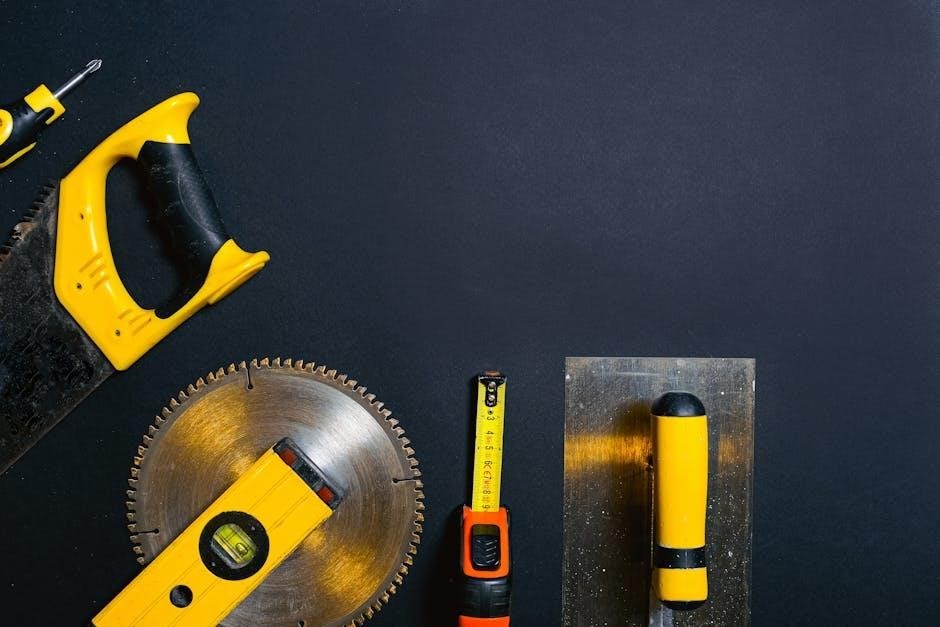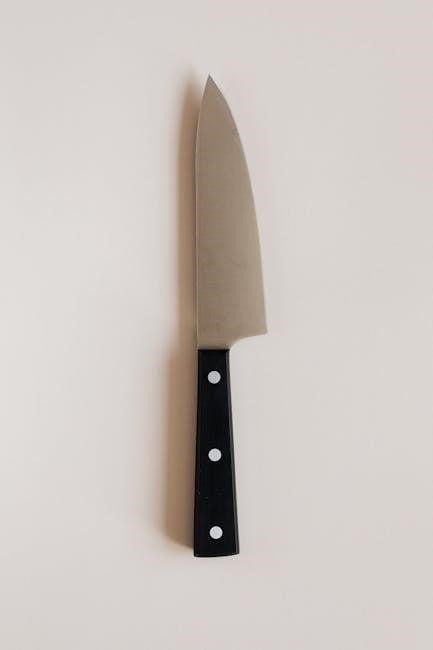Understanding scalpel blade sizes is crucial for precision and effectiveness in surgical and crafting procedures. Blades vary in size, shape, and edge type, with numbers indicating specific dimensions. Common sizes like 10, 6, and 11 cater to different tasks, ensuring optimal results. Whether for surgery or art, selecting the right blade enhances accuracy and safety. This guide provides an overview of blade sizes, materials, and types, helping users make informed choices for their specific needs.

Understanding Scalpel Blade Sizes
Scalpel blade sizes are standardized to ensure precision in various procedures. The numbering system indicates blade dimensions, with common sizes ranging from 6 to 25. Size 10 is widely used for general surgery, while others like 11 and 6 serve specific purposes. The shape and edge type, such as curved or serrated, also vary to match task requirements. Proper blade selection enhances accuracy and safety, making it vital to understand these differences for optimal results in both medical and crafting applications.
Overview of Blade Sizes
Scalpel blades come in a variety of sizes, each designed for specific tasks and procedures. The size of a scalpel blade is determined by its length, shape, and edge type, with the numbering system providing a standardized way to identify these characteristics. Blades are typically categorized into smaller, medium, and larger sizes, catering to different levels of precision and durability required in medical, surgical, and crafting applications.

Smaller blade sizes, such as 6 or 10, are often used for precise incisions and delicate procedures. These blades are ideal for tasks that require fine control, such as skin grafting or intricate dissections. Medium-sized blades, including sizes 11 and 15, offer a balance between precision and strength, making them suitable for general surgery and crafting projects. Larger blades, such as size 20 or 25, are designed for heavier-duty tasks, including deeper incisions or cutting through tougher materials.

The shape of the blade also plays a critical role in its functionality. Curved blades are preferred for making smooth, rounded incisions, while straight blades are better suited for linear cuts. Serrated blades, on the other hand, are used for cutting through tougher tissues or materials, as their serrated edge provides additional grip and cutting power. The combination of size and shape ensures that users can select the most appropriate blade for their specific needs.
In addition to size and shape, the thickness and flexibility of the blade are important factors. Thinner blades are more flexible and ideal for precise cuts, while thicker blades are more rigid and durable, making them suitable for heavier use. The materials used in blade construction, such as high-carbon stainless steel, also contribute to their performance, ensuring sharpness and longevity.
Understanding the relationship between blade size, shape, and material is essential for achieving optimal results in any application. Whether for surgery, crafting, or industrial use, selecting the right blade size ensures precision, safety, and efficiency. This guide provides a detailed breakdown of blade sizes, helping users make informed decisions based on their specific requirements.
Common Scalpel Blade Sizes
Scalpel blades are available in a range of standardized sizes, each designed for specific surgical or crafting tasks. Among the most commonly used blade sizes are 6, 10, 11, 15, 20, and 25. These sizes are widely recognized and utilized across medical and industrial applications due to their versatility and effectiveness.
Size 6 blades feature a curved cutting edge, making them ideal for creating smooth, rounded incisions. They are frequently used in procedures requiring precise control, such as skin grafting or delicate dissections. Size 10 blades, with their straight cutting edge and strong tip, are popular for general surgery and making linear incisions. Their robust design makes them suitable for both shallow and deeper cuts.
Size 11 blades are known for their extended cutting edge and fine point, offering exceptional precision for intricate procedures. They are often preferred for tasks like suturing or fine dissection, where a sharp, reliable edge is essential. Size 15 blades combine a curved edge with a strong tip, making them versatile for both cutting and scraping tasks. They are commonly used in ophthalmology and other specialized surgical fields.
Larger blade sizes, such as 20 and 25, are designed for heavier-duty applications. These blades are typically thicker and more rigid, providing durability for deeper incisions or cutting through tougher materials. They are often used in orthopedic or general surgical procedures where more force is required.
In addition to these sizes, serrated blades are available for tasks requiring additional grip and cutting power. For example, serrated size 10 blades are useful for cutting through dense tissues or materials. The choice of blade size depends on the specific requirements of the procedure, including the type of tissue, the depth of the cut, and the desired level of precision.
Understanding the most common scalpel blade sizes and their applications is essential for ensuring optimal performance and safety. Whether for surgical use or crafting, selecting the right blade size enhances accuracy, reduces the risk of complications, and improves overall outcomes. This section provides a detailed overview of the most frequently used blade sizes, helping users make informed decisions for their specific needs.

Understanding the Blade Numbering System
The scalpel blade numbering system is a standardized method used to identify blade sizes and shapes. This system helps users quickly determine the appropriate blade for their specific needs, ensuring compatibility and effectiveness. The numbering system is based on the blade’s dimensions, including its length, width, and edge type.
Each blade size is assigned a unique number, typically ranging from 6 to 25. These numbers correspond to specific measurements, such as the blade’s length and thickness, as well as its edge characteristics. For example, a size 10 blade is shorter and thinner than a size 20 blade, making it suitable for more delicate procedures. The numbering system also accounts for the blade’s shape, with curved, straight, or serrated edges indicated by specific designations.
The blade numbering system is further divided into subcategories, such as A or P designations. These letters provide additional information about the blade’s specific features, such as its tip type or edge configuration. For instance, a 10A blade is a straight-edged blade with a strong tip, while an 11P blade has an extended cutting edge with a long, fine point.
Understanding the blade numbering system is crucial for selecting the right blade for a particular task. It ensures that the blade’s size, shape, and edge type are appropriate for the procedure, optimizing both performance and safety. This section provides a detailed explanation of the blade numbering system, helping users decipher the meaning behind each number and make informed decisions when choosing a scalpel blade.

Types of Scalpel Blades

Scalpel blades are categorized into distinct types based on their shape, edge, and intended use. Straight blades, like the popular size 11, are ideal for precise, straight cuts, while curved blades, such as size 10, are better suited for incisions requiring a rounded edge. Serrated blades offer a rough edge for tougher tissues, and chisel blades are designed for scraping or shaving tasks. Each type is tailored to specific surgical or crafting needs, ensuring optimal performance and accuracy.
Straight vs. Curved Blades
The choice between straight and curved scalpel blades depends on the specific task at hand. Straight blades, such as the popular size 11, are designed for precise, straight cuts. They feature a sharp, straight edge that excels in tasks requiring linear incisions, such as skin cuts in surgery or straight-line trimming in crafting. Their rigid structure makes them ideal for situations where control and accuracy are paramount. For example, size 11 blades are often used in general surgery for making clean, straight incisions, while crafters favor them for precise cuts in materials like paper or plastic.
In contrast, curved blades, like the size 10, are better suited for tasks that require a rounded cutting edge. Their curved shape allows for smooth, continuous cuts in areas where a straight blade would be less effective. Size 10 blades, for instance, are commonly used in surgical procedures for making incisions in curved or irregular tissue. Similarly, crafters often prefer curved blades for creating rounded edges or intricate designs in their work. The curvature of these blades provides greater maneuverability in tight spaces, making them indispensable for detailed tasks.
The decision between straight and curved blades ultimately comes down to the nature of the task. Straight blades are best for linear cuts and precision, while curved blades excel in situations requiring flexibility and rounded edges. Both types are essential in surgical and crafting contexts, offering unique advantages that cater to specific needs. By selecting the appropriate blade shape, users can ensure optimal results and enhance their workflow efficiency.
Serrated vs. Non-Serrated Blades
Scalpel blades are available in two primary types: serrated and non-serrated, each designed for specific applications. Serrated blades feature a toothed edge, which provides a stronger grip on tissue or material, making them ideal for cutting through tough or fibrous substances. These blades are commonly used in surgical procedures where extra grip is necessary, such as in dense tissue dissection. For example, the 20mm serrated blade is often preferred for its ability to handle challenging materials effectively. The serrations increase the blade’s durability and reduce the risk of slipping during use.
Non-serrated blades, on the other hand, have a smooth, straight or curved edge, making them suitable for precise, delicate cuts. These blades are typically used in general surgery, crafting, and other tasks that require fine control. Popular sizes like 10 and 11 are favored for their sharp, clean cutting edges, which leave minimal trauma to the material or tissue. Non-serrated blades are also easier to maintain and sharpen, as their smooth surface reduces wear and tear. However, they may lack the grip provided by serrated blades, making them less effective for certain applications.

The choice between serrated and non-serrated blades depends on the task’s requirements. Serrated blades excel in scenarios where a firm grip and aggressive cutting are necessary, while non-serrated blades are better suited for precision and fine detail work. Understanding the differences between these blade types ensures that users select the most appropriate tool for their needs, optimizing both safety and efficiency. Whether in surgery or crafting, the right blade type can significantly impact the outcome of the procedure.
Chisel Scalpel Blades
Chisel scalpel blades are specialized tools designed for specific surgical and procedural tasks. Unlike standard blades, chisel blades feature a unique edge that is tailored for scraping rather than cutting. These blades are often used in procedures where precise removal or shaping of material is required, such as in orthopedic or dental surgeries. Their design makes them particularly effective for tasks that involve smoothing surfaces or removing small amounts of tissue.

The chisel scalpel blade is characterized by its flat, beveled edge, which provides a broad surface area for scraping. This design allows for controlled removal of material without causing excessive damage to surrounding tissue or structures. Chisel blades are typically available in various sizes, with the width of the blade varying to suit different applications. Narrower blades, such as the 10535, are ideal for detailed work, while wider blades may be used for broader scraping tasks.
One of the key advantages of chisel blades is their versatility. They are compatible with standard scalpel handles, making them a convenient addition to a surgeon’s or practitioner’s toolkit. The blades are constructed from high-quality surgical stainless steel, ensuring durability and sharpness even after repeated use. Their rigid construction also provides stability during procedures, reducing the risk of accidental damage or breakage.
Chisel scalpel blades are particularly valued in situations where precision is critical. For example, they are often used in neurosurgery for delicate tissue removal or in plastic surgery for shaping grafts. Their unique design allows for fine control, enabling practitioners to achieve the desired results with minimal trauma to the surrounding area. While chisel blades may not be suitable for all surgical applications, they are an essential tool for specific procedures that require precise scraping or shaping.

Materials and Construction
Scalpel blades are crafted from high-quality materials to ensure durability, precision, and safety. The primary material used is high-carbon stainless steel, which is renowned for its hardness, corrosion resistance, and ability to maintain a sharp edge. This steel alloy is carefully formulated to achieve a hardness rating of 50 to 58 on the Rockwell Hardness Scale (HRC), ensuring optimal performance during surgical or crafting procedures. The blades are designed to withstand the rigors of repeated use while maintaining their sharpness and structural integrity.
The construction of scalpel blades involves a precise manufacturing process. The blades are forged, heat-treated, and ground to exact specifications. Forging ensures a strong molecular structure in the steel, while heat treatment enhances the blade’s hardness and flexibility. The grinding process shapes the blade to its desired form, whether it is straight, curved, serrated, or chisel-edged. Finally, the blade is sharpened to a razor-sharp edge using advanced techniques that maximize its cutting efficiency.
Surgical scalpel blades are typically between 0.3mm and 1.0mm in thickness, with the specific thickness determined by the blade’s intended use. Thinner blades are more flexible and ideal for delicate procedures, while thicker blades provide greater rigidity for tougher tasks. The handles of scalpels are usually made from durable materials such as stainless steel or high-quality plastics, ensuring a secure grip and long-lasting performance. Disposable scalpels often feature ergonomic handles made from lightweight polymers, with some models including protective guards for added safety.
The materials and construction of scalpel blades are subject to strict quality control standards. Blades are sterile or sterilizable, making them suitable for surgical environments. Additionally, many modern scalpels are designed with environmental considerations in mind, using recyclable materials wherever possible. The combination of premium materials, precise engineering, and rigorous testing ensures that scalpel blades meet the high demands of medical and crafting professionals worldwide.





